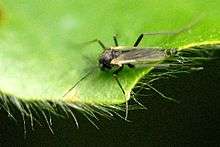Polypedilum
| Polypedilum | |
|---|---|
 | |
| Polypedilum nubens | |
| Scientific classification | |
| Kingdom: | Animalia |
| Phylum: | Arthropoda |
| Class: | Insecta |
| Order: | Diptera |
| Suborder: | Nematocera |
| Infraorder: | Culicomorpha |
| Superfamily: | Chironomoidea |
| Family: | Chironomidae |
| Subfamily: | Chironominae |
| Tribe: | Chironomini |
| Genus: | Polypedilum Kieffer, 1912 |
| Subgenera | |
| Synonyms | |
| |
Polypedilum is a genus of non-biting midges in the subfamily Chironominae of the bloodworm family Chironomidae. This is probably the most species-rich of all chironomid genera. Larvae of Polypedilum may also be among the most abundant invertebrates in euthrophic ponds, reaching densities of up to 1200 larvae per square meter.[1]
Species
- Subgenus Cerobregma Zhang & Wang 1999
- P. paucisetum Zhang & Wang, 2009)
- Subgenus Pentapedilum Kieffer, 1913
- P. botiense Oyewo & Sæther, 2008[2]
- P. scirpicola (Kieffer, 1921)
- P. botosaneanui Oyewo & Sæther, 2008[2]
- P. camposense Oyewo & Sæther, 2008[2]
- P. exsectum (Kieffer, 1916)
- P. intuber Oyewo & Sæther, 2008[2]
- P. nubens (Edwards, 1929)
- P. reei Oyewo & Sæther, 2008[2]
- P. sordens (van der Wulp, 1874)
- P. tissamaharense Oyewo & Sæther, 2008[2]
- P. tritum (Walker, 1856)
- P. wittei (Freeman, 1955)
- Subgenus Polypedilum Kieffer, 1912
- P. acutum Kieffer, 1915
- P. albicorne (Meigen, 1838)
- P. albosignatum Kieffer, 1925
- P. amoenum Goetghebuer, 1930
- P. arundineti (Goetghebuer, 1921)
- P. barboyoni Serra-Tosio, 1981
- P. dudichi Berczik, 1957
- P. fallax (Johannsen, 1905)
- P. intermedium Albu & Botnariuc, 1966
- P. laetum (Meigen, 1818)
- P. lene (Becker, 1908)
- P. nubeculosum (Meigen, 1804)
- P. nubifer (Skuse, 1889)
- P. octopunctatum (Thunberg, 1784)
- P. pedestre (Meigen, 1830)
- P. vanderplanki Hinton, 1951
- Subgenus Tripodura Townes, 1945
- P. acifer Townes, 1945
- P. aegyptium Kieffer, 1925
- P. akani Bjørlo, 2001[3]
- P. amplificatus Bjørlo, 2001[3]
- P. amputatum Bjørlo, 2001[3]
- P. apfelbecki (Strobl, 1900)
- P. bicrenatum Kieffer, 1921
- P. chelum Vårdal, 2001[3]
- P. dagombae Bjørlo, 2001[3]
- P. elongatum Albu, 1980
- P. ewei Bjørlo, 2001[3]
- P. malickianum Cranston, 1989
- P. ogoouense Bjørlo, 2001[3]
- P. patulum Bjørlo, 2001[3]
- P. pulchrum Albu, 1980
- P. pullum (Zetterstedt, 1838)
- P. quadriguttatum Kieffer, 1921
- P. scalaenum (Schrank, 1803)
- P. spinalveum Vårdal, 2001[3]
- P. tetracrenatum Hirvenoja, 1962
- Subgenus Uresipedilum Oyewo & Sæther, 1998
- P. convictum (Walker, 1856)
- P. cultellatum Goetghebuer, 1931
- P. marsafae Ghonaim, Ali & Osheibah, 2005
This list is incomplete; you can help by expanding it.
References
- ↑ Int Panis, L; Bervoets L; Verheyen RF (1995). "The spatial distribution of Caenis horaria (L., 1758) (Caenidae, Ephemeroptera) in a pond in Niel (Belgium)". Bull. Annls Soc. belge Ent. 131: 47–51.
- 1 2 3 4 5 6 Emmanuel Adeoye Oyewo & Ole A. Sæther (2008). Revision of Polypedilum (Pentapedilum) Kieffer and Ainuyusurika Sasa et Shirasaki (Diptera: Chironomidae). 1953. New Zealand: Magnolia Press. pp. 145 pp. ISBN 978-1-86977-300-7.
- 1 2 3 4 5 6 7 8 9 Vårdal, H., Bjørlo, A. & Sæther, O. A. (2002). "Afrotropical Polypedilum subgenus Tripodura, with a review of the subgenus (Diptera: Chironomidae)". Zoologica Scripta. Wiley InterScience. 31 (4): 331–402. doi:10.1046/j.1463-6409.2002.00096.x.
This article is issued from Wikipedia - version of the 6/13/2016. The text is available under the Creative Commons Attribution/Share Alike but additional terms may apply for the media files.